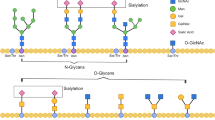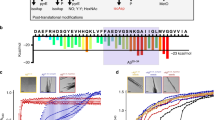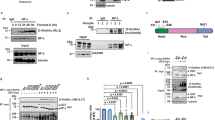Abstract
Alzheimer's disease (AD) is characterized by the presence of numerous neurons with neurofibrillary tangles of paired helical filaments (PHFs). The microtubule–associated protein tau in abnormally hyperphosphorylated form is the major protein subunit of the PHF. We now show that PHF tangles isolated from AD brains are glycosylated, whereas no glycan is detected in normal tau. Deglycosylation of PHF tangles by endoglycosidase F/N–glycosidase F converts them into bundles of straight filaments 2.5 ± 0.5 nm in diameter, similar to those generated by the interaction of normal tau and abnormally hyperphosphorylated tau (AD P–tau). Deglycosylation plus dephosphorylation, but not deglycosylation alone, of AD P–tau and tau from PHF tangles restores their microtubule polymerization activity. Dephosphorylation of deglycosylated PHF tangles results in increased tau release. Thus, although the abnormal phosphorylation might promote aggregation of tau and inhibition of the assembly of microtubules, glycosylation appears to be responsible for the maintenance of the PHF structure.
This is a preview of subscription content, access via your institution
Access options
Subscribe to this journal
Receive 12 print issues and online access
$209.00 per year
only $17.42 per issue
Buy this article
- Purchase on Springer Link
- Instant access to full article PDF
Prices may be subject to local taxes which are calculated during checkout
Similar content being viewed by others
References
Braak, H., Braak, E., Grundke-Iqbal, I. & Iqbal, K. Occurrence of neuropil threads in the senile human brain and in Alzheimer's disease: A third location of paired helical filaments outside of neurofibrillary tangles and neuritic plaques. Neurosci. Lett. 65, 351–355 (1986).
Tomlinson, B.E., Blessed, G. & Roth, M. Observations on the brains of demented old people. J. Neurol. Sci. 11, 205–242 (1970).
Alafuzoff, I., Iqbal, K., Friden, H., Adolfsson, R. & Winblad, B. Histopathological criteria for progressive dementia disorders: Clinical-pathological correlation and classification by multivariate data analysis. Acta Neuropathol. (Berl.) 74, 209–225 (1987).
Grundke-Iqbal, I. et al. Microtubule-associated protein tau: A component of Alzheimer paired helical filaments. J. Biol Chem. 261, 6084–6089 (1986).
Grundke-Iqbal, I. et al. Abnormal phosphorylation of the microtubule-associated protein τ (tau) in Alzheimer cytoskeletal pathology. Proc. Natl. Acad. Sci. USA 83, 4913–4917 (1986).
Iqbal, K. et al. Defective brain microtubule assembly in Alzheimer's disease. Lancet 2, 421–426 (1986).
Köpke, E. et al. Microbutule associated protein tau: Abnormal phosphorylation of a non-paired helical filament pool in Alzheimer disease. J. Biol. Chem. 268, 24374–24384 (1993).
Drubin, D.G. & Kirschner, M.W. Tau protein function in living cells. J. Cell Biol. 103, 2739–46 (1986).
Ruben, G.C. et al. The microtubule associated protein tau forms a triple-stranded left-hand helical polymer. J. Biol. Chem. 266, 22019–22027 (1991).
Goux, W.J., Rodriguez, S. & Sparkman, D.R. Analysis of the core components of Alzheimer paired helical filaments: A gas chromatography/mass spectrometry characterization of fatty acids, carbohydrates and long-chain bases. FEBS Lett. 366, 81–85 (1995).
Ruben, G.C., Iqbal, K., Wisniewski, H.M., Johnson, J.E., Jr., & Grundke-Iqbal, I. Alzheimer neurofibrillary tangles contain 2.1 nm filaments structurally identical to the microtubule associated protein tau: A high resolution transmission electron microscope study of tangles and senile plaque core amyloid. Brain Res. 590, 164–179 (1992).
Alonso, A., del, C., Grundke-Iqbal, I. & Iqbal, K. Alzheimer disease hyperphos-phorylated tau sequesters normal tau into tangles of filaments and disassembles microtubules. Nature Med. 2, 783–787 (1996).
Wang, J.-Z., Gong, C.-X., Zaidi, T., Grundke-Iqbal, I. & Iqbal, K. Dephosphorylation of Alzheimer paired helical filaments by protein phosphatase-2A and -2B. J. Biol. Chem. 270, 4854–4860 (1995).
Smith, M.A. et al. Advanced Maillard reaction end products are associated with Alzheimer disease pathology. Proc. Natl. Acad. Sci. USA 91, 5710 (1994).
Ledesma, M.D., Bonay, P., Colaco, C. & Avila, J. Analysis of microtubule-associated protein tau glycation in paired helical filaments. J. Biol. Chem. 269, 21614–21619 (1994).
Yan, S.D. et al. Glycated tau protein in Alzheimer disease: A mechanism for induction of oxidant stress. Proc. Natl. Acad. Sci. USA 91, 7787 (1994).
Ledesma, M.D., Bonay, P. & Avila, J. τ Protein from Alzheimer's disease patients is glycated at its tubulin-binding domain. J. Neurochem. 65, 1658 (1995).
Tanaka, S., Avigad, G., Brodsky, B. & Eikenberry, E.F. Glycation induces expansion of molecular packing of collagen. J. Mol Biol. 203, 495–505 (1988).
Bancher, C. et al. Accumulation of abnormally phosphorylated tau precedes the formation of neurofibrillary tangles in Alzheimer's disease. Brain Res. 477, 90–99 (1989).
Yan, S.D. et al. Non-enzymatically glycated tau in Alzheimer's disease induces neuronal oxidant stress resulting in cytokine gene expression and release of amyloid β-peptide. Nature Med. 1, 693–699 (1995).
Papasozomenos, S.ch. Tau protein immunoreactivity in dementia of the Alzheimer type. II. Electron microscopy and pathogenetic implications: Effects of fixation on the morphology of the Alzheimer's abnormal filaments. Lab. Invest. 60, 375–389 (1989).
Brandt, R., Léger, J. & Lee, G. Interaction of tau with the neural plasma membrane mediated by tau's amino-terminal projection domain. J. Cell Biol. 131, 1327–1340 (1995).
Mason, R.P., Trumbore, M.W. & Pettegrew, J.W. Membrane interactions of a phosphomonoester elevated early in Alzheimer's disease. Neurobiol. Aging 16, 531–539 (1995).
Zubenko, G.S. et al. Platelet membrane fluidity in Alzheimer's disease. Alzheimer Dis. Assoc. Disord. 2, 179 (1988).
Sherrington, R. et al. Cloning of a gene bearing missense mutations in early-onset familial Alzheimer's disease. Nature 375, 754–760 (1995).
Rogaev, E.I. et al. Familial Alzheimer's disease in kindreds with missense mutations in a gene on chromosome I related to the Alzheimer's disease type 3 gene. Nature 376, 775–778 (1995).
Kang, J. et al. The precursor of Alzheimer's disease amyloid A4 protein resembles a cell surface receptor. Nature 325, 733–736 (1987).
Goate, A. et al. Segregation of a missense mutation in the amyloid precursor protein gene with familial Alzheimer's disease. Nature 349, 704–706 (1991).
Iqbal, K., Zaidi, T., Thompson, C.H., Merz, P.A. & Wisniewski, H.M. Alzheimer paired helical filaments: Bulk isolation, solubility and protein composition. Acta. Neuropathol. (Berl.) 62, 167–177 (1984).
Bensadoun, A. & Weinstein, D. Assay of proteins in the presence of interfering materials. Anal. Biochem. 70, 241–250 (1976).
Wisniewski, H.M., Merz, P.A. & Iqbal, K. Ultrastructure of paired helical filaments of Alzheimer's neurofibrillary tangle. J. Neuropathol. Exp. Neurol. 43, 643–656 (1984).
Cohen, P. et al. Protein phosphatase-1 and protein phosphatase-2A from rabbit skeletal muscle. Methods Enzymol. 159, 390–408 (1988).
Khatoon, S., Grundke-Iqbal, I. & Iqbal, K. Brain levels of microtubule-associated protein tau are elevated in Alzheimer's disease: A radioimmuno-slot-blot assay for nanograms of the protein. J. Neurochem. 59, 750–753 (1992).
Author information
Authors and Affiliations
Rights and permissions
About this article
Cite this article
Wang, JZ., Grundke-Iqbal, I. & Iqbal, K. Glycosylation of microtubule–associated protein tau: An abnormal posttranslational modification in Alzheimer's disease. Nat Med 2, 871–875 (1996). https://doi.org/10.1038/nm0896-871
Received:
Accepted:
Issue Date:
DOI: https://doi.org/10.1038/nm0896-871
This article is cited by
-
Tau and neuroinflammation in Alzheimer’s disease: interplay mechanisms and clinical translation
Journal of Neuroinflammation (2023)
-
New insight into protein glycosylation in the development of Alzheimer’s disease
Cell Death Discovery (2023)
-
The Involvement of Post-Translational Modifications in Regulating the Development and Progression of Alzheimer’s Disease
Molecular Neurobiology (2023)
-
Regulation of Neurodegeneration-associated Protein Fragments by the N-degron Pathways
Neurotoxicity Research (2022)
-
The Role of Post-Translational Modifications on the Structure and Function of Tau Protein
Journal of Molecular Neuroscience (2022)



